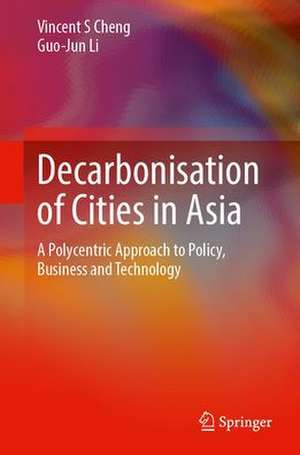Decarbonization of Cities in Asia: A Polycentric Approach to Policy, Business and Technology
Autor Vincent S. Cheng, Guo-Jun Lien Limba Engleză Hardback – 13 sep 2023
Preț: 893.84 lei
Preț vechi: 1090.06 lei
-18% Nou
Puncte Express: 1341
Preț estimativ în valută:
171.04€ • 179.03$ • 142.36£
171.04€ • 179.03$ • 142.36£
Carte tipărită la comandă
Livrare economică 31 martie-14 aprilie
Preluare comenzi: 021 569.72.76
Specificații
ISBN-13: 9789819928378
ISBN-10: 9819928370
Ilustrații: XIV, 233 p. 74 illus., 66 illus. in color.
Dimensiuni: 155 x 235 mm
Greutate: 0.53 kg
Ediția:1st ed. 2023
Editura: Springer Nature Singapore
Colecția Springer
Locul publicării:Singapore, Singapore
ISBN-10: 9819928370
Ilustrații: XIV, 233 p. 74 illus., 66 illus. in color.
Dimensiuni: 155 x 235 mm
Greutate: 0.53 kg
Ediția:1st ed. 2023
Editura: Springer Nature Singapore
Colecția Springer
Locul publicării:Singapore, Singapore
Cuprins
Chapter 1. Overview of Energy Consumption in Cities.- Chapter 2. Energy and Carbon Emissions.- Chapter 3. Drivers in Built Environment.- Chapter 4. Scenarios of Carbon Neutrality.- Chapter 5. Decarbonisation: Buildings, District Energy, Transportation, and Renewables.- Chapter 6. Net Zero Energy, Policy, and Behaviour Change.
Notă biografică
Vincent S. Cheng is the fellow and director of Climate and Sustainability at Arup in East Asia. Dr. Cheng has over 25 years of professional experience in building energy efficiency and is an expert on decarbonization of property developments and cities across Asia. He serves at the Hong Kong Green Building Council and many committees of governments of the region, advising policy issues on carbon neutrality and climate resilience.
Guo-Jun is a sustainability expert at Arup who is deeply passionate about innovative and data-driven engineering solutions in sustainable development. He has ample project experience in delivering sustainability solutions for clients, including partaking in master-planning projects for carbon-neutral campuses, energy and building physics simulations for buildings, carbon portfolio analysis and target setting and whole life-cycle carbon assessments (WLCAs) in both the United States and in the East Asia region.
Guo-Jun is a sustainability expert at Arup who is deeply passionate about innovative and data-driven engineering solutions in sustainable development. He has ample project experience in delivering sustainability solutions for clients, including partaking in master-planning projects for carbon-neutral campuses, energy and building physics simulations for buildings, carbon portfolio analysis and target setting and whole life-cycle carbon assessments (WLCAs) in both the United States and in the East Asia region.
Textul de pe ultima copertă
This book provides best practices for decarbonizing cities in East Asia, in which buildings are the major contributor to carbon emissions. Beyond the global commitment through the Paris Agreement to make collective efforts on climate action and accelerated policies, investment and development at the country and city level to combat climate change are occurring at an unprecedented rate. Rapid urbanization and increasing energy demand for large and dense Asian cities require smart and sustainable strategies to balance development with decarbonization. A poly-centric approach is needed, where a combination of policy-, market- and technology-driven changes can aid the transition towards development of carbon neutral cities. With practical examples in the implementation of the United Nations Sustainable Development Goals, green financing, climate action roadmap and policy, deployment of renewable energy, and low- to zero-carbon buildings, readers can find the motivation, considerations and implementation pathways to facilitate the transition into the new normal. It is the hope of the authors to encourage readers to see successful pathways in transitioning into a carbon-free industry and overcoming the effects of climate extremes.
Caracteristici
Provides a comprehensive analysis of policy and market conditions to support discussions of building decarbonization Illustrates in-depth technical designs including methodologies and simulations Contributes real-life projects with excellent illustrations
